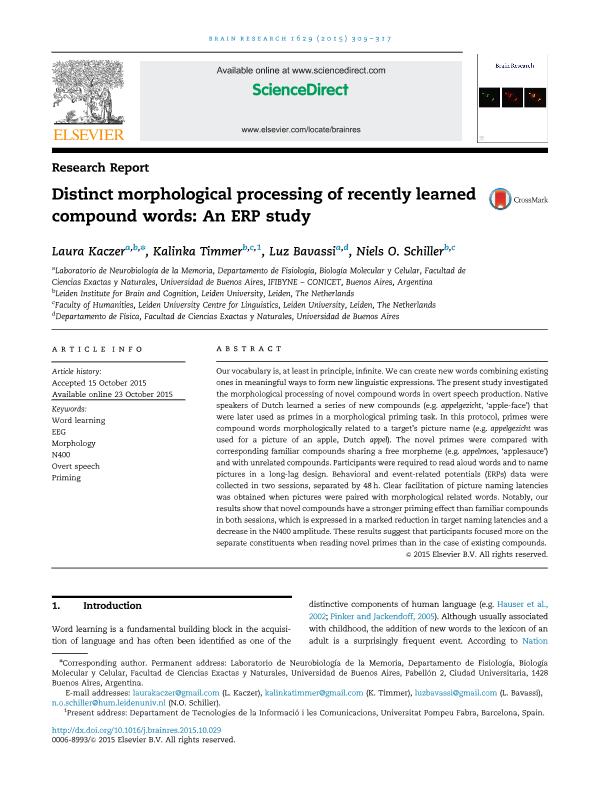Mostrar el registro sencillo del ítem
dc.contributor.author
Kaczer, Laura

dc.contributor.author
Timmer, Kalinka
dc.contributor.author
Bavassi, Mariana Luz

dc.contributor.author
Schiller, Niels
dc.date.available
2018-05-11T21:10:32Z
dc.date.issued
2015-11
dc.identifier.citation
Kaczer, Laura; Timmer, Kalinka; Bavassi, Mariana Luz; Schiller, Niels; Distinct morphological processing of recently learned compound words: An ERPstudy; Elsevier Science; Brain Research; 1629; 11-2015; 309-317
dc.identifier.issn
0006-8993
dc.identifier.uri
http://hdl.handle.net/11336/44995
dc.description.abstract
Our vocabulary is, at least in principle, infinite. We can create new words combining existing ones in meaningful ways to form new linguistic expressions. The present study investigated the morphological processing of novel compound words in overt speech production. Native speakers of Dutch learned a series of new compounds (e.g. appelgezicht, ?apple-face?) that were later used as primes in a morphological priming task. In this protocol, primes were compound words morphologically related to a target?s picture name (e.g. appelgezicht was used for a picture of an apple, Dutch appel). The novel primes were compared with corresponding familiar compounds sharing a free morpheme (e.g. appelmoes, ?applesauce?) and with unrelated compounds. Participants were required to read aloud words and to name pictures in a long-lag design. Behavioral and event-related potentials (ERPs) data were collected in two sessions, separated by 48 h. Clear facilitation of picture naming latencies was obtained when pictures were paired with morphological related words. Notably, our results show that novel compounds have a stronger priming effect than familiar compounds in both sessions, which is expressed in a marked reduction in target naming latencies and a decrease in the N400 amplitude. These results suggest that participants focused more on the separate constituents when reading novel primes than in the case of existing compounds.
dc.format
application/pdf
dc.language.iso
eng
dc.publisher
Elsevier Science

dc.rights
info:eu-repo/semantics/openAccess
dc.rights.uri
https://creativecommons.org/licenses/by-nc-sa/2.5/ar/
dc.subject
Word Learning
dc.subject
Eeg
dc.subject
Morphology
dc.subject
Priming
dc.subject.classification
Otras Ciencias Biológicas

dc.subject.classification
Ciencias Biológicas

dc.subject.classification
CIENCIAS NATURALES Y EXACTAS

dc.title
Distinct morphological processing of recently learned compound words: An ERPstudy
dc.type
info:eu-repo/semantics/article
dc.type
info:ar-repo/semantics/artículo
dc.type
info:eu-repo/semantics/publishedVersion
dc.date.updated
2018-05-11T20:54:35Z
dc.journal.volume
1629
dc.journal.pagination
309-317
dc.journal.pais
Países Bajos

dc.journal.ciudad
Amsterdam
dc.description.fil
Fil: Kaczer, Laura. Leiden University; Países Bajos. Consejo Nacional de Investigaciones Científicas y Técnicas. Oficina de Coordinación Administrativa Ciudad Universitaria. Instituto de Fisiología, Biología Molecular y Neurociencias. Universidad de Buenos Aires. Facultad de Ciencias Exactas y Naturales. Instituto de Fisiología, Biología Molecular y Neurociencias; Argentina
dc.description.fil
Fil: Timmer, Kalinka. Leiden University; Países Bajos
dc.description.fil
Fil: Bavassi, Mariana Luz. Consejo Nacional de Investigaciones Científicas y Técnicas. Oficina de Coordinación Administrativa Ciudad Universitaria. Instituto de Fisiología, Biología Molecular y Neurociencias. Universidad de Buenos Aires. Facultad de Ciencias Exactas y Naturales. Instituto de Fisiología, Biología Molecular y Neurociencias; Argentina
dc.description.fil
Fil: Schiller, Niels. Leiden University; Países Bajos
dc.journal.title
Brain Research

dc.relation.alternativeid
info:eu-repo/semantics/altIdentifier/doi/http://dx.doi.org/10.1016/j.brainres.2015.10.029
dc.relation.alternativeid
info:eu-repo/semantics/altIdentifier/url/https://www.sciencedirect.com/science/article/pii/S0006899315007908
Archivos asociados
